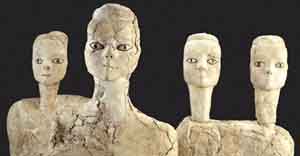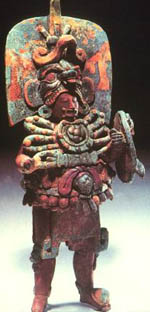
6,000 year old plaster statues from 'Ain Ghazal--
an early farming village in Jordan.
Lost
Tribes & Buried Cities
Click
here to see a sample schedule..
This
a sample, it is NOT the course syllabus.
This section of Buried Cities and Lost Tribes takes a topical approach. We'll start with the hunters of the ice age, move on to examine the start of farming, and look at the rise of ancient civilizations. Be sure to visit the Blackbboard Learn page hosted by NAU's Information Technology Services.
| Approximately one-half of the course focuses on the Old World. We will spend a few weeks examining how people survived the ice age -- and the fabulous cave art from 20,000 years ago. Then we'll look at crisis at occurred as the glaciers retreated and global warming forced people to become farmers. Finally, we'll look at the rise of settled village life in the eastern Mediterranean, temperate Europe, and parts of Asia. This half of the course will include (but not be limited to) examining:
|
 Standing Stone from the henge monument at Stenness, Orkney Islands -- off the north coast of Scotland |
|
The second half of the course concentrates on the New World. This part of the course will examine three regions in Central America: early villages on the Gulf Coast, Maya cities in eastern region, and the rise of civilizations in the Highlands. We'll also examine cities in the Andes that came well before the Inca.
|
Assigned Readings:
No single textbook is sufficient for this course. The price of textbooks is simply too high to ask students to buy two or three books when you'd only be reading a few chapters from each. All readings will be available through Internet links or on e-reserve through Cline Library. You can read the articles on-line or you can print the articles to read as hard copy. When possible, I will put the books on reserve at Cline Library. Those of you who live near Flagstaff can use the books on reserve, if you don't like using on-line articles.
Assigned Videos:
During the course you will be assigned full-length videos from Films On Demand and through Kaltura, the streaming service NAU uses. Kaltura and Films on Demand stream the videos, and your computer does not need any special software to watch the videos.Anticipated workload
During a traditional semester students will have one course unit per week, and each takes the place of a week's worth of in-class lectures. During a compressed, eight-week course, you can expect an average of two units per week. During the Winter or Summer terms, you can expect to complete three or four units per week. You should expect to spend two or three hours per unit on the Internet. You should use a laptop or desktop computer -- it is not recommended to try to type an assignment or take a quiz on a cell phone.
Do you have questions about taking this as a web course? Read frequently asked questions. If you don't see the answer, email me, the instructor: Dr. Susan Smiley

Rollout Photograph of Maya Vase
